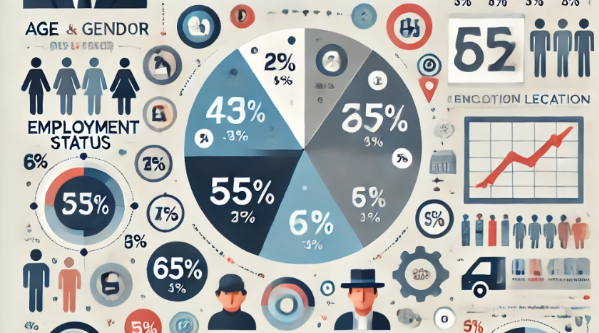In today’s competitive business landscape, understanding your target audience is more crucial than ever. Demographic profiling has emerged as an indispensable tool for marketers seeking to create highly targeted and effective campaigns. By leveraging data on age, gender, income, education, and other key factors, companies can tailor their messaging and offerings to resonate with specific customer segments. This article delves into the world of demographic profiling, exploring its importance, methods, and real-world applications.
What is Demographic Profiling?
Demographic profiling is the process of collecting and analyzing data about a population or market segment based on factors such as age, gender, income, education, occupation, and location. This information helps businesses understand the characteristics of their target audience, allowing them to create more personalized and effective marketing strategies.
The importance of demographic profiling cannot be overstated. It enables companies to:
- Identify and understand their ideal customers
- Tailor products and services to meet specific needs
- Create more targeted and effective marketing campaigns
- Allocate marketing resources more efficiently
- Improve customer satisfaction and loyalty
Key Demographic Factors
To create accurate and useful profiles, marketers focus on several key demographic factors:
Age: Different age groups have distinct preferences, behaviors, and purchasing power. Understanding age demographics helps businesses tailor their messaging and product offerings accordingly.
Gender: While gender-based marketing has become more nuanced in recent years, it remains an important factor in many industries.
Income: Income levels significantly influence purchasing decisions and brand preferences.
Education: Educational background can impact consumer behavior, brand perceptions, and product preferences.
Occupation: A person’s profession often correlates with their interests, needs, and purchasing habits.
Location: Geographic data helps businesses understand regional preferences and tailor their strategies accordingly.
Ethnicity: Cultural backgrounds can influence consumer behavior and preferences.
Family Status: Marital status and family composition affect purchasing decisions and lifestyle choices.
Data Collection Methods
To gather demographic data, marketers employ a variety of methods:
Surveys: Online and offline surveys provide direct insights from consumers.
Census Data: Government-collected data offers a broad overview of population demographics.
Market Research: Professional research firms conduct in-depth studies on specific market segments.
Digital Analytics: Online tools track user behavior and demographic information across websites and social media platforms.
Customer Relationship Management (CRM) Systems: These databases store valuable customer information gathered through various touchpoints.
Segmentation and Targeting
Once demographic data is collected, the next step is to use it effectively. This is where segmentation and targeting come into play.
Segmentation involves dividing a larger market into smaller, more manageable groups based on shared characteristics. For example, a clothing retailer might segment their market by age, gender, and income level.
Targeting is the process of selecting which segments to focus on and how to reach them effectively. This might involve creating specific marketing campaigns for each segment or prioritizing certain segments based on their potential value to the business.
Trends and Innovations in Demographic Profiling
As technology advances, so do the methods and applications of demographic profiling:
AI and Machine Learning: These technologies are revolutionizing data analysis, allowing for more accurate predictions and insights.
Data Privacy and Ethics: With increasing concerns about data protection, businesses must balance effective profiling with ethical considerations and compliance with regulations like GDPR.
Shifting Demographics: As population demographics change, marketers must adapt their strategies to remain relevant.
Micro-Segmentation: Advanced data analytics now allow for hyper-targeted marketing, sometimes down to the individual level.
Real-World Applications
Many companies have successfully leveraged demographic profiling to drive their marketing efforts:
Nike: The sportswear giant uses demographic data to create targeted campaigns for different age groups and athletic interests.
Procter & Gamble: P&G’s “Thank You, Mom” campaign for the Olympics effectively targeted mothers across various demographics.
Netflix: The streaming service uses viewer demographics and behavior to recommend content and create targeted marketing campaigns.
Coca-Cola: The “Share a Coke” campaign used demographic data to personalize product packaging with popular names in different regions.

Challenges and Limitations
While demographic profiling is a powerful tool, it’s not without its challenges:
- Data accuracy and reliability
- Overreliance on stereotypes
- Rapidly changing demographics
- Privacy concerns and regulations
- Integration of demographic data with other marketing strategies
Best Practices for Effective Demographic Profiling
To maximize the benefits of demographic profiling, consider these best practices:
- Regularly update your data to ensure accuracy
- Combine demographic data with psychographic and behavioral insights for a more comprehensive understanding
- Use multiple data sources to cross-verify information
- Respect privacy laws and ethical considerations
- Continuously test and refine your segmentation and targeting strategies
Tools and Technologies
Several tools can assist in demographic profiling:
Google Analytics: Provides demographic insights for website visitors Facebook Audience Insights: Offers detailed demographic data on Facebook users Nielsen: Provides comprehensive market research and consumer insights Experian: Offers data-driven marketing solutions and consumer profiling tools
Premier Pitch Deck Consultants often emphasize the importance of incorporating demographic insights into business presentations to demonstrate a deep understanding of target markets.
The Future of Demographic Profiling
As we look ahead, several trends are likely to shape the future of demographic profiling:
- Increased integration of AI and machine learning for more accurate predictions
- Greater emphasis on real-time data analysis and dynamic segmentation
- More sophisticated methods of combining demographic data with other types of consumer insights
- Continued focus on privacy and ethical considerations in data collection and usage
- Growing importance of global demographic trends in international marketing strategies
Conclusion
Demographic profiling remains a cornerstone of effective marketing strategies. By understanding the characteristics and preferences of their target audience, businesses can create more personalized, relevant, and impactful marketing campaigns. As technology continues to evolve, the possibilities for demographic profiling will only expand, offering marketers even more powerful tools to connect with their ideal customers.
However, with great power comes great responsibility. As we harness the potential of demographic profiling, it’s crucial to balance effectiveness with ethical considerations and respect for consumer privacy. By doing so, businesses can build stronger, more meaningful relationships with their customers while driving growth and success in an increasingly competitive marketplace.







